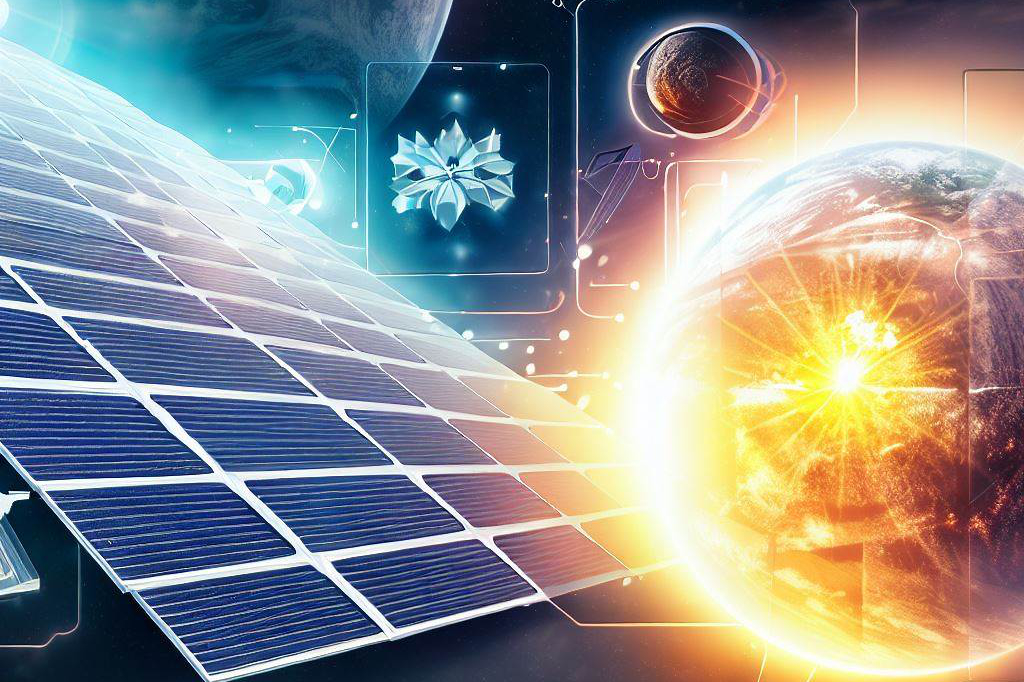The Current State of Global Energy Security
Global energy security is a critical issue that affects everyone. As our population grows, so does our demand for energy. Unfortunately, the majority of our energy is still derived from finite resources such as coal and oil, which are not only subject to depletion but also contribute to environmental degradation.
Additionally, the dependence on these resources has led to political instability in some regions around the world. This can cause price hikes and supply disruptions that affect not only individual countries but also the global economy as a whole.
The Concept of Space-Based Renewable Energy Production
One technology that could potentially address these issues is space-based renewable energy production. The idea is to place solar panels or other renewable energy sources in space where they can collect sunlight constantly without interruption from weather conditions or nightfall. This concept has been around since the 1960s, but it hasn’t been fully realized due to technical and economic challenges.
However, recent advances in technology have made it more feasible than ever before. If successful, this technology could revolutionize how we think about generating electricity and provide an alternative source of energy that is sustainable and reliable.
The Benefits of Space-Based Renewable Energy Production

Reduced Dependence on Finite Resources like Fossil Fuels
We all know that fossil fuels are finite resources, meaning that they won’t last forever. As the demand for energy continues to increase with population growth and economic development, we need to look towards alternative sources of energy that are both sustainable and renewable. Space-based renewable energy production has the potential to revolutionize our global energy system by providing clean and unlimited energy from the sun.
Space-based solar power systems would be able to capture more solar radiation than Earth-based systems due to their unobstructed view of the sun, as well as their ability to operate 24/7 without being affected by weather conditions. This could significantly reduce our dependency on finite resources like coal, oil, and gas.
Increased Energy Security through Diversification of Energy Sources
Diversification is a key principle in any risk management strategy. The same approach applies to our global energy system. Relying on a single source for our energy needs can make us vulnerable to supply disruptions or price spikes caused by geopolitical tensions or natural disasters.
By diversifying our sources of energy, we can reduce these risks and increase our overall energy security. Space-based renewable energy production can become an important component of this diversified portfolio by providing a stable source of electricity that is not subject to geopolitical tensions or resource availability constraints.
Potential for Increased Efficiency and Cost-Effectiveness
One major advantage of space-based solar power systems is that they can provide power continuously without interruption due to bad weather or time restrictions (like daytime only). Additionally, since there is no air resistance in space, unlike on earth (where air resistance reduces efficiency), space based solar panels would be far more efficient than earth based ones.
Due to its scale, cost-effectiveness will be paramount for space based energy production to be sustainable. The upfront costs of developing and launching these systems into space will be high, but over time, the cost per watt could decrease as technology advances and economies of scale are achieved.
Furthermore, since there is no need to build power lines across long distances with potential for line loss, energy can be transferred wirelessly or through short cables from the satellite directly to earth, which could reduce infrastructure costs. Overall, space-based renewable energy production has the potential to provide substantial benefits in terms of reducing dependence on finite resources like fossil fuels, increasing energy security through diversification of energy sources, and increasing efficiency and cost-effectiveness.
The Challenges and Limitations of Space-Based Renewable Energy Production

Technical Challenges in Developing and Deploying Such Systems
The idea of space-based renewable energy production sounds like something out of a science fiction novel, but the reality is that it poses significant technical challenges. One major hurdle is the need for a way to transmit the energy back to Earth.
The proposed methods involve either beaming the energy via microwaves or transmitting it via lasers, both of which require significant technological advances to be viable. Additionally, developing and deploying solar panel arrays on such a large scale in space also requires technological innovation, including improvements in materials science and robotics.
Cost Considerations and Potential Economic Barriers
Another challenge facing space-based renewable energy production is cost. The initial investment required for such a project would be astronomical (pun intended). While proponents argue that over time, space-based renewable energy could become more cost-effective than traditional fossil fuel sources due to a lack of resource depletion and other factors, it would still require tremendous upfront capital.
Furthermore, there are also concerns about economic barriers that may prevent widespread adoption of this technology. For example, developing nations may not have access to the necessary resources or funding required to participate in such initiatives.
Regulatory Hurdles and International Cooperation Needed
Regulatory hurdles pose another challenge for space-based renewable energy production. There are few international agreements on how space resources can be used or who has jurisdiction over them, particularly with regard to private entities investing in this area. Additionally, there are concerns about potential environmental impacts from transmitting microwave or laser beams back to Earth from outer space.
Addressing these issues will require international cooperation and collaboration among government agencies and private corporations alike. Overall, while the potential benefits of space-based renewable energy production are significant, there remain substantial challenges that must be addressed before this technology can become a reality.
From technical challenges to cost considerations and regulatory hurdles, the road ahead is paved with obstacles. However, with continued innovation and cooperation among stakeholders, the possibility of clean energy from space may someday become a reality.
Exploring Current Initiatives and Research in Space-Based Renewable Energy Production

Overview of Various Projects Around The World, Including NASA’s Space Solar Power Initiative
There are several initiatives currently underway around the world to explore space-based renewable energy production. One such initiative is NASA’s Space Solar Power Initiative (SSPI), which aims to develop technologies that can capture solar energy in space and transmit it back to Earth for use.
The project has been ongoing since 2016 and has already made significant strides in terms of technology development. Other countries, including Japan and China, have also been exploring similar projects.
Japan launched a satellite in 2019 that successfully tested a microwave transmission system for beaming solar power from space. In China, researchers have been working on developing a space-based solar power station that could provide 24/7 renewable energy to the country.
Recent Technological Advancements That Have Made This Concept More Feasible
One major technological advancement that has made space-based renewable energy production more feasible is the development of lightweight solar panels. These panels are more efficient than traditional silicon-based panels and can be transported more easily into space.
Another key advancement is the development of wireless power transmission technology. This allows for the transmission of energy from satellites in space to receivers on Earth without the need for physical wires or cables.
This technology is still being refined but holds great potential for future use. Additionally, advancements in materials science have led to the creation of new materials that can withstand the harsh conditions of space while also being lightweight and durable enough for use in satellite construction.
Overall, these recent technological advancements have made it possible to seriously consider space-based renewable energy production as a viable option for global energy security. As research continues, we may see even more breakthroughs that further enhance this concept’s feasibility and potential impact on our planet’s future sustainability.
Potential Impacts on Global Politics, Economics, and Society

The New Space Race
The potential for space-based renewable energy production has the power to spark a new space race among nations. Countries that are able to master this technology will have a significant advantage over those that do not. This could lead to geopolitical shifts in power and alliances, as countries seek to secure access to this valuable resource.
Furthermore, it may create new tensions between countries that have traditionally relied on fossil fuels for their energy needs. As demand for traditional sources of fuel decreases, those countries may experience economic hardships and social unrest as they try to adapt to a changing world.
New Job Opportunities and the Decline of Fossil Fuels
The potential impact on job markets is another important consideration when it comes to space-based renewable energy production. While this technology would create new job opportunities in fields such as engineering, construction, and maintenance of space-based solar panels, it could also lead to job losses in the traditional fossil fuel industry.
Some have argued that the decline of fossil fuels could lead to economic hardship for certain regions or communities. However, proponents of space-based renewable energy production argue that the transition away from fossil fuels is inevitable and should be embraced as an opportunity for growth and progress.
Potential Environmental Benefits

A Clean Energy Alternative
One major benefit of space-based renewable energy production is its potential impact on the environment. Unlike traditional sources of fuel like coal or oil, this technology would produce clean energy without contributing carbon dioxide emissions or other harmful pollutants into the atmosphere.
This has important implications for climate change mitigation efforts. If we are able to make significant progress towards replacing traditional sources of fuel with clean alternatives like space-based solar power, we may be better equipped to avoid some of the worst impacts of climate change.
Reducing Environmental Damage
Another environmental benefit of space-based renewable energy production is its potential to reduce the damage caused by traditional methods of energy production. For example, oil spills and other accidents associated with oil drilling can have devastating impacts on ecosystems and wildlife.
By transitioning away from these methods and towards clean alternatives, we may be able to minimize the risk of environmental disasters like these. This would not only protect our planet, but also help to preserve some of the world’s most precious natural resources for future generations.
Looking Ahead

While there are certainly technical, economic, and regulatory hurdles that need to be overcome before space-based renewable energy production can become a reality, recent advancements in technology and increased international cooperation are promising signs. Additionally, the potential benefits of this technology extend far beyond just ensuring reliable access to energy – it could also have positive impacts on global politics, economics, and environmental sustainability.
While it may be some time before we see large-scale deployment of space-based renewable energy solutions, the potential rewards for doing so are great. As we continue to explore new technologies for meeting our growing energy needs while minimizing our impact on the planet, space-based renewable energy will undoubtedly remain an important avenue for further research and innovation.
TL;DR – FAQs
– ⚡ Space-based renewable energy production has the potential to revolutionize global energy security by reducing dependence on finite resources like fossil fuels.
– 🌍 Increased energy security can be achieved through diversification of energy sources, and space-based renewable energy can provide a stable source of electricity not subject to geopolitical tensions or resource availability constraints.
– 💰 Space-based solar power systems offer potential for increased efficiency and cost-effectiveness compared to Earth-based systems, with uninterrupted power generation and wireless energy transfer.
– 🚀 Technical challenges, cost considerations, and regulatory hurdles need to be addressed for space-based renewable energy production to become a reality.
– 🌐 Various initiatives and research projects, including NASA’s Space Solar Power Initiative, are exploring space-based renewable energy production.
– 🔬 Recent technological advancements, such as lightweight solar panels and wireless power transmission, have made space-based renewable energy production more feasible.
– 🌍 The potential impacts include a new space race, changes in global politics and alliances, job opportunities in new sectors, and positive environmental benefits.

C M, a seasoned editor, journalist, and consultant, is deeply fascinated by the convergence of technology, space, and the future of humanity.
With a particular interest in transhumanity, futurology, and the philosophical and ethical dimensions of these domains, C M serves as the lead contributor to SpaceSpotlight and TranscendSphere.
When not penning insightful articles on these rapidly evolving fields, C M indulges in their love for podcasts and books, proudly embracing their status as a ‘Happy Nerd Extraordinaire!’



